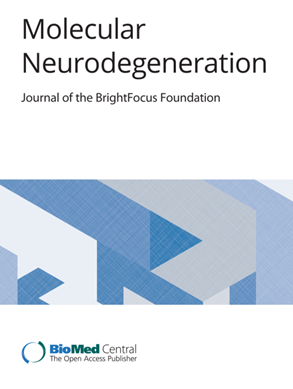阿尔茨海默病的发病机制:站在脂质代谢与免疫反应的十字路口
IF 17.5
1区 医学
Q1 NEUROSCIENCES
引用次数: 0
摘要
阿尔茨海默病(AD)是一种神经退行性疾病,以皮层萎缩、脑回狭窄、脑沟扩大和脑室增大等宏观特征为特征。在细胞水平上,病理特征包括β-淀粉样蛋白(Aβ)在细胞外聚集形成老年斑,以及细胞内过度磷酸化的tau蛋白积聚形成神经原纤维缠结。阿尔茨海默病会导致认知、行为和社交能力的逐渐下降,目前尚无有效的治疗方法。AD的病理生理是复杂的,涉及免疫失调和脂质代谢改变等机制。免疫细胞,如小胶质细胞,可以在疾病早期识别和清除病理聚集物,如Aβ。然而,免疫细胞的长时间或过度激活可能引发慢性神经炎症,从而加速神经元损伤和AD的进展。脂质代谢在维持细胞膜结构和功能、调节a β的产生和清除以及向大脑提供能量方面起着至关重要的作用。这些过程的中断与阿尔茨海默病的病理进展密切相关。脂质代谢与免疫系统的相互作用进一步加剧了AD的疾病进展。在本文中,我们讨论了AD的脂质代谢和免疫反应,总结了它们之间复杂的相互作用,并强调了多因子致病级联的复杂性,为针对AD的免疫代谢轴的新干预提供了新的见解。本文章由计算机程序翻译,如有差异,请以英文原文为准。
Alzheimer’s disease pathogenesis: standing at the crossroad of lipid metabolism and immune response
Alzheimer’s disease (AD) is a neurodegenerative disorder characterized by macroscopic features such as cortical atrophy, narrowing of the gyri, widening of the sulci, and enlargement of the ventricles. At the cellular level, the pathological characteristics include the extracellular aggregation of β-amyloid (Aβ) forming senile plaques, and the intracellular accumulation of hyperphosphorylated tau proteins forming neurofibrillary tangles. AD leads to the progressive decline of cognitive, behavioral, and social abilities, with no effective treatment available currently. The pathophysiology of AD is complex, involving mechanisms such as immune dysregulation and lipid metabolism alterations. Immune cells, such as microglia, can identify and clear pathological aggregates like Aβ early in the disease. However, prolonged or excessive activation of immune cells may trigger chronic neuroinflammation, thereby accelerating neuronal damage and the progression of AD. Lipid metabolism plays a critical role in maintaining cell membrane structure and function, regulating the production and clearance of Aβ, and supplying energy to the brain. Disruptions in these processes are closely linked to the pathological progression of AD. The interaction between lipid metabolism and the immune system further exacerbates the disease progression of AD. In this review, we discuss the lipid metabolism and immune response in AD, summarize their intricate interactions, and highlight the complexity of the multifactorial pathogenic cascade, offering insights into new interventions targeting the immune-metabolic axis in AD.
求助全文
通过发布文献求助,成功后即可免费获取论文全文。
去求助
来源期刊

Molecular Neurodegeneration
医学-神经科学
CiteScore
23.00
自引率
4.60%
发文量
78
审稿时长
6-12 weeks
期刊介绍:
Molecular Neurodegeneration, an open-access, peer-reviewed journal, comprehensively covers neurodegeneration research at the molecular and cellular levels.
Neurodegenerative diseases, such as Alzheimer's, Parkinson's, Huntington's, and prion diseases, fall under its purview. These disorders, often linked to advanced aging and characterized by varying degrees of dementia, pose a significant public health concern with the growing aging population. Recent strides in understanding the molecular and cellular mechanisms of these neurodegenerative disorders offer valuable insights into their pathogenesis.
 求助内容:
求助内容: 应助结果提醒方式:
应助结果提醒方式:


